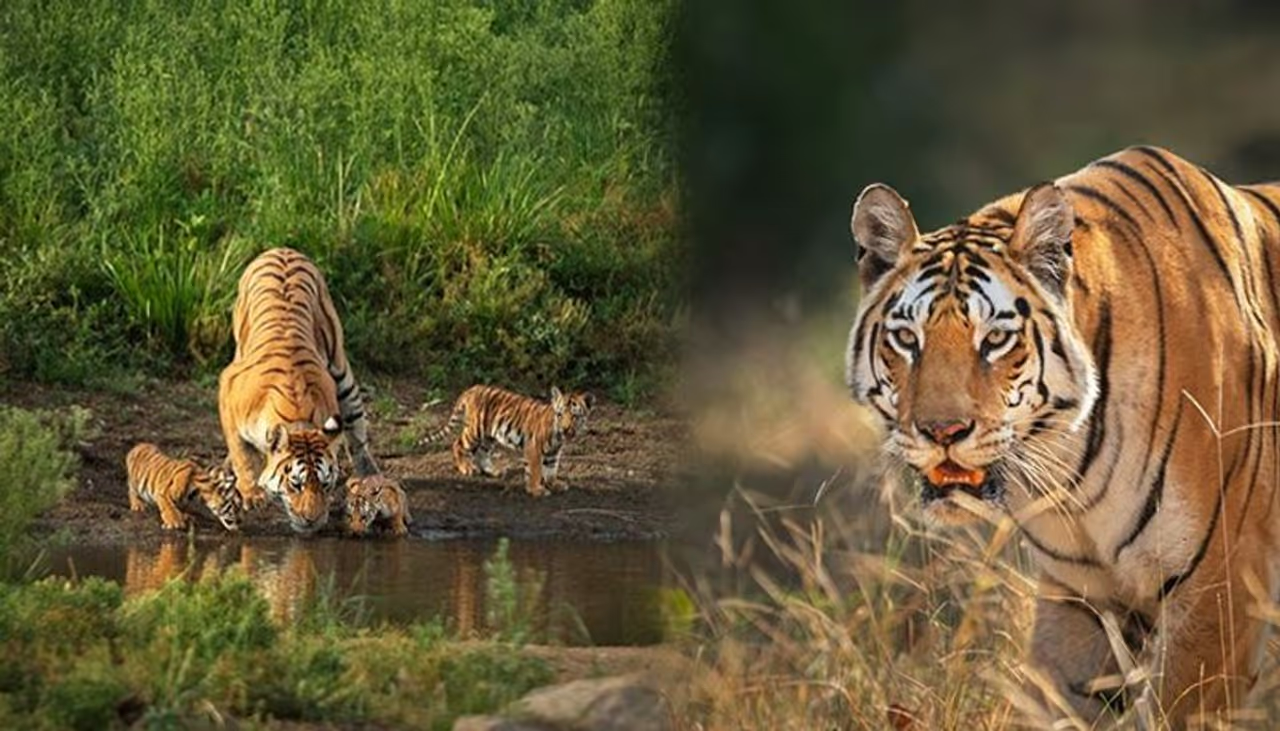7 reasons why 'Collarwali' was one of her kind
Madhya Pradesh’s ‘Supermom’, tigress ‘Collarwali’ breathed her last on January 15 in Pench Tiger Reserve. Asianet Newsable's Divya Bhonsale presents you seven aspects that made Collarwali the 'Queen of Pench'.

Image: Sarosh Lodhi/By special arrangement
One of India's most popular tigresses, ‘Collarwali’ passed into the ages on January 15 but has left behind a legacy of her own. Tigress T-15, born in the year 2005, was one of the first few tigers who were radio-collared in 2008. And that is where she popularly came to be known as ‘Collarwali’, a name that has been etched in the history of Indian wildlife. While the radio collar was a distinctive mark about her, what made her world-famous was the record that she held.

Image: Sarosh Lodhi/By special arrangement
In her lifetime, Collarwali, also known as Mataram, went on to deliver 29 cubs from eight litters. And of those 29 cubs, at least 25 cubs survived. The stakeholders of the wildlife community – be it the forest officials, wildlife photographers, activists, naturalists or tourists have been mourning her passing away.
As a tribute to the tigress that single-handedly helped in increasing the tiger population of the country, we present to you some lesser-known aspects of Collarwali – from her birth to death.
WATCH THE VIDEO HERE: https://youtu.be/-LckNVgq6E0
Image: Sarosh Lodhi/By special arrangement
She was filmed in a documentary as a cub: Wildlife photographer for over two decades, Sarosh Lodhi, is one of those who have closely seen Collarwali grow up from a cub to becoming the ‘Supermom’. Speaking to this reporter, Lodhi recalls that Collarwali was filmed in a tiger documentary as a cub. “Collarwali was born to ‘Badi Mada’. A documentary called ‘Spy in the Jungle’, possibly of BBC, had featured her as a cub,” said Lodhi.
ALSO READ: MP: 13 tigers claws, 2 canines recovered from Bandhavgarh; three arrested
Image: Sarosh Lodhi/By special arrangement
Her contribution to Panna’s tiger population: While many may believe that all those cubs of Collarwali who survived, were in Pench, there are claims that she also indirectly helped in the Panna re-introduction of tigers project which was started in 2009. According to Ajay Dubey, a wildlife activist, says, “When three tigresses were sent to Panna Tiger Reserve in phases from 2009, one of those tigresses was the daughter of Collarwali. So, not just Pench but Collarwali also helped in increasing the tiger population of Panna, which had once lost all its tigers.”
ALSO READ: Omicron derails India's bid to bring cheetah out of extinction
Image: Sarosh Lodhi/By special arrangement
Survived cases of poisoning: Ajay Duber further says that at one point in time, Pench was looking at many cases of tiger poisoning. “There was a time when cases of tiger poisoning in Pench were high. But Collarwali sailed through that time. And not just her, but she was successful in keeping her cubs also safe,” said Dubey.
Image: Sarosh Lodhi/By special arrangement
Collarwali was never aggressive: Sarosh Lodhi has observed Collarwali over all the years that he photographed her in the jungles of Pench. Ask him if ever came off as aggressive, he says, “No, she was never aggressive. She, in fact, was tourist-friendly.” The same is also observed by Ajay Dubey who says, “Even Sultana, a tigress in Ranthambore Tiger Reserve, had attacked a tourist vehicle but that was not the case with Collarwali. She, since the beginning, has given great shows to tourists and wildlife photographers by coming in open areas and walking freely."
Image: Sarosh Lodhi/By special arrangement
Contribution to making Pench a tourist-friendly park: Ajay Dubey further highlighted that Collarwali had a big contribution in making Pench Tiger Reserve become the best in the country for park management as well as for being tourist-friendly. “Collarwali has never disappointed the photographers and the tourists with her sightings. People were largely dragged to the park to sight her. These factors are countable in terms of why Pench is considered as a tourist-friendly park,” explained the Bhopal-based wildlife enthusiast and activist.
Image: Sarosh Lodhi/By special arrangement
It’s rare for tigers to die in open areas: Collarwali was last spotted by tourists on January 14. She came into an open area and lay there for hours. She died the next day on January 15. Speaking of tigers and their natural deaths, Ajay Dubey said that it is very rare for a tiger to come out in an open area and die a natural death. He explains, “Tigers prefer to die in dark and secluded areas. But Collarwali chose to breathe her last in an open area which is very rare to happen among the tigers.”
Image: Sarosh Lodhi/By special arrangement
The dominance on her territory continued till the last: When a tiger grows old, it is pushed out of its territory by a young tiger. However, in Collarwali’s case, Ajay Dubey says that she had her dominance on her territory till the very last.
Image: Sarosh Lodhi/By special arrangement
Collarwali was undoubtedly one of the most loved tigers of Madhya Pradesh. She was a delight to photographers and tourists alike. But made her special for the successful litters she delivered over the years that rightfully got her the title of 'Supermom'. And while she will no longer be seen in the jungles of Pench, Collarwali will continue to live through her tales, and moreover, through the lineage that she has left behind.
Stay updated with the Breaking News Today and Latest News from across India and around the world. Get real-time updates, in-depth analysis, and comprehensive coverage of India News, World News, Indian Defence News, Kerala News, and Karnataka News. From politics to current affairs, follow every major story as it unfolds. Get real time updates from IMDon major cities' weather forecasts, including Rain alerts, Cyclonewarnings, and temperature trends. Download the Asianet News Official App for accurate and timely weather updates anytime, anywhere.